📑Table of Contents:
- 1. Plovdiv: A Tapestry of Time
- 2. The Bulgarian Cyrillic Alphabet
- 3. The Blue Eye
- 4. Bulgarian Yogurt
- 5. Rila Monastery
- 6. The Emblematic Bulgarian Lion
- 7. The Belogradchik Rocks
- 8. The Varna Necropolis
- 9. Rose Oil Production
- 10. Melnik: Architectural and Vinicultural Harmony
- 11. Healing Waters
- 12. The Thracian Tombs
- 13. Preserving Traditional Crafts
- 14. Sozopol: A Blend of Antiquity and Beauty
- 15. Thracian Beehive Tombs
- 16. Koprivshtitsa: A Revival of Bulgarian Spirit
- 17. The Rich Tapestry of Bulgarian Folk Music and Dance
Bulgaria captivates global travelers with its ancient history and stunning natural beauty. Here’s an in-depth look at 17 interesting facts about Bulgaria, highlighting its cultural richness and diverse landscapes.

1. Plovdiv: A Tapestry of Time
Plovdiv isn’t just an ancient city; it’s a testament to human civilization, with over 8,000 years of continuous habitation. Also, as one of the oldest cities globally, Plovdiv has witnessed numerous cultural transformations, from its Thracian origins to Roman occupation and its role in the Ottoman Empire.
Moreover, the city’s architecture is a mosaic of its storied past, featuring Roman theaters, medieval walls, Ottoman baths, and a beautifully preserved Old Town that reflects the National Revival architecture.
Today, Plovdiv is a vibrant cultural hub, hosting numerous festivals, such as the famous Plovdiv International Fair, and a dynamic arts scene. Moreover, it was a proud European Capital of Culture in 2019, which brought even greater attention to its rich heritage and artistic innovation.
2. The Bulgarian Cyrillic Alphabet
Saint Cyril and Saint Methodius developed the Cyrillic alphabet, a cornerstone of Bulgarian identity in the 9th century. This script was part of their mission to convert the Slavic peoples to Christianity. Originally intended to translate religious texts into the Slavic languages, the Cyrillic script quickly became entrenched as a fundamental element of Slavic cultural identity. This script facilitates communication in Bulgaria and fosters a deep sense of national pride.
Additionally, schools teach the history and significance of the Cyrillic alphabet, emphasizing its role in preserving Bulgarian literature and folklore. The alphabet’s adoption has enabled the preservation of Bulgaria’s literary and cultural heritage, making it an essential tool for artistic expression and continuity.
3. The Blue Eye
Similarly, nestled in the Rhodope Mountains, the Blue Eye Spring is a natural wonder that draws visitors with its beauty. This karst spring, known for its deep, vibrant blue color and crystal-clear waters, creates a natural pool that seems almost supernatural. The surrounding landscape of lush forests and mountain vistas also makes the Blue Eye a perfect destination for nature lovers and photographers.
Furthermore, local legends enhance the allure with tales of mystical beings inhabiting the waters. Beyond its beauty, the Blue Eye is a starting point for numerous hiking trails, offering adventurers the chance to explore the Rhodope Mountains’ serene and pristine environment.
This area, rich in biodiversity and natural beauty, is ideal for those seeking tranquility and a connection with nature.
4. Bulgarian Yogurt
Bulgarian yogurt, or ‘kilo make,’ is renowned worldwide for its creamy texture and health benefits. This traditional yogurt contains Lactobacillus bulgaricus, a bacterium found naturally in the Bulgarian climate. The unique properties of this bacterium give Bulgarian yogurt its distinct sour taste and thick consistency.
Bulgarians also consume yogurt as a food and a health remedy, believing in its gastrointestinal benefits. The tradition of yogurt-making dates back thousands of years, rooted in pastoral practices passed down through generations.
Today, kilo mlyako remains a staple in the Bulgarian diet, enjoyed on its own or used as a base in dishes like the cold soup tarator. Additionally, its international recognition as a superfood has boosted Bulgaria’s profile as a leader in dairy production.
5. Rila Monastery
The Rila Monastery, Bulgaria’s largest and most famous monastery, is in the majestic Rila Mountains. Founded by Saint John of Rila in the 10th century, the monastery is both a spiritual center and a symbol of the struggle for Bulgarian self-identity throughout centuries of foreign rule. Its architecture is a striking example of the National Revival style, with intricate carvings and colorful frescoes depicting biblical scenes.
These beautiful artworks serve as a narrative of Bulgaria’s religious and cultural history. The monastery includes a museum that houses a collection of historical artifacts, including old manuscripts, garments, and crafts, offering insights into monastic life.
This UNESCO World Heritage Site attracts pilgrims and tourists alike, drawn by its spiritual significance and stunning natural surroundings. It is a place of peace and reflection where visitors can sense the enduring strength of Bulgaria’s cultural heritage.
6. The Emblematic Bulgarian Lion
The Bulgarian flag prominently features the lion, a powerful symbol of courage and strength. This emblem symbolizes the nation’s resilience and fierce independence throughout its history. The lion has been a national symbol since medieval times when it appeared on Bulgarian rulers’ and warriors’ coats of arms.
Today, it represents not just the bravery of the Bulgarian people but also their sovereignty and cultural integrity. Bulgarians take pride in this symbol, omnipresent in public spaces, government buildings, and national events.
It reminds us of Bulgaria’s rich heritage and the unyielding spirit that has defined it through various epochs.
7. The Belogradchik Rocks
The Belogradchik Rocks, an array of sandstone and conglomerate rock formations in the northwestern part of Bulgaria, are one of the country’s most astonishing natural landmarks. These rocks vary in color from red to yellow to gray and are often associated with fascinating legends and myths. Some formations, such as the Madonna and the Monk, are named for their shapes.
The rocks are a tourist attraction and a testament to nature’s artistry, sculpting landscapes over millions of years. Surrounding the formations are remnants of the Belogradchik Fortress, which utilized the natural obscurity of the rocks as a strategic defense.
This site perfectly blends natural wonder and historical significance, offering spectacular views and a glimpse into Bulgaria’s past.
8. The Varna Necropolis
Discovered in the necropolis of Varna, this ancient gold treasure is the oldest processed gold found in Europe, dating back over 6,000 years. The artifacts include jewelry, utensils, and symbolic items, indicating a sophisticated understanding of metallurgy by the Varna culture.
The treasure provides invaluable insights into prehistoric society’s social structure and rituals. Archaeologists believe that the quantity and quality of the gold artifacts suggest that Varna was a major cultural and economic center.
The discovery of the Varna gold has redefined our understanding of prehistoric civilizations, showing a level of sophistication previously unattributed to this period.
9. Rose Oil Production
Due to its superior quality, Bulgaria’s rose oil is highly prized in the global perfumery and cosmetics industries. The oil is extracted from the petals of Rosa damascena, the oil-bearing rose, which thrives in the unique climate and soil conditions of the Rose Valley.
This region celebrates its rose-growing tradition annually during the Rose Festival, where visitors can participate in the rose-picking process and enjoy folk performances.
The meticulous process of harvesting and distillation, often done by hand, has been perfected over centuries. This industry contributes significantly to Bulgaria’s economy and perpetuates an aromatic and beautiful cultural legacy.
10. Melnik: Architectural and Vinicultural Harmony
Despite being Bulgaria’s smallest town, Melnik boasts an outsized cultural footprint and is known for its distinctive sandstone cliffs and historical architecture. The town’s houses, built in the traditional Bulgarian Revival style, feature ornate woodwork and are nestled harmoniously among the striking natural landscapes.
The local wineries, often small and family-run, offer tours that allow visitors to experience the rich flavors and traditions of Bulgarian winemaking. This blend of natural beauty and cultural richness makes Melnik a captivating stop on Bulgaria’s cultural map.
11. Healing Waters
With over 600 natural mineral and thermal springs, Bulgaria is one of Europe’s top spa and wellness tourism destinations. These waters are rich in minerals believed to have health-promoting properties, attracting locals and tourists seeking therapeutic and relaxation experiences.
The country’s spa resorts combine modern wellness treatments with ancient bathing traditions, creating a holistic health approach deeply embedded in Bulgarian culture.
Places like Hisarya, Velingrad, and Sandanski offer wellness retreats set against scenic landscapes, providing a serene environment for healing and relaxation.
12. The Thracian Tombs
The Thracian tombs scattered across Bulgaria offer a rare glimpse into the Thracian civilization, which flourished in the region from as early as 4000 BC until being absorbed by the Roman Empire. These burial sites, often richly decorated with frescoes and containing exquisite gold artifacts, highlight the Thracians’ advanced artistic and cultural practices. The most famous of these, the Kazanlak Tomb, is a UNESCO World Heritage Site that draws scholars and tourists alike.
The tombs serve as a testament to the Thracian’s architectural and artistic achievements and provide insights into their beliefs about the afterlife and the cosmos.
13. Preserving Traditional Crafts
Bulgaria’s commitment to preserving traditional crafts, such as pottery, embroidery, and woodcarving, reflects a broader desire to connect to the past. Artisans nationwide continue to practice these crafts, often using techniques passed down through generations. These items are more than souvenirs; they represent Bulgaria’s cultural identity. Craft festivals and markets are popular, allowing artisans to display their skills and sell wares.
This continuation of traditional arts is vital for cultural preservation, supports local economies, and keeps ancient skills alive in the modern world.
14. Sozopol: A Blend of Antiquity and Beauty
Sozopol is one of Bulgaria’s oldest coastal towns, dating back to the 7th century BC. Originally a Greek colony known as Apollonia, it boasts many historical sites, including medieval churches and ancient ruins. The town’s charm is amplified by its scenic location on the Black Sea coast, with beautiful beaches and a bustling marina. Sozopol’s Old Town, a maze of narrow cobblestone streets and traditional wooden houses, offers a picturesque backdrop that feels like stepping back in time.
During the annual Apollonia Arts Festival, the town comes alive with music, art, and theater, celebrating its rich heritage and vibrant contemporary culture.
15. Thracian Beehive Tombs
The unique architectural style of the Thracian beehive tombs is an intriguing aspect of Bulgaria’s archaeological landscape. These tombs, characterized by their circular plans and domed roofs, resemble the shape of beehives.
Found primarily in the Thracian Valley, these structures are believed to have been used as burial sites for the Thracian nobility. Their construction techniques demonstrate a sophisticated understanding of geometry and engineering.
Excavations of these tombs often reveal richly furnished burial chambers with various artifacts, providing insight into the Thracians’ ceremonial practices and social hierarchy.
16. Koprivshtitsa: A Revival of Bulgarian Spirit
Koprivshtitsa embodies the spirit of the Bulgarian National Revival with its well-preserved 19th-century architecture and historical significance. Today, Koprivshtitsa is a living museum with colorful houses and cobblestone streets that glimpse Bulgaria’s revolutionary past.
The town is also a cultural hub, hosting festivals celebrating traditional Bulgarian music, dance, and customs, drawing visitors keen to experience Bulgaria’s rich historical and cultural heritage.
17. The Rich Tapestry of Bulgarian Folk Music and Dance
Bulgarian folk music and dance are integral to national identity, celebrated and preserved through performances and festivals. The horo, a traditional circle dance, is a staple at Bulgarian gatherings, symbolizing unity and community. Each region of Bulgaria has its distinct dance style and music, reflecting the diverse influences shaping its cultural landscape. Instruments like the gadulka, kaval, and bagpipe are essential to Bulgarian folk music, creating a lively, haunting sound.

Bulgaria has diverse landscapes, a rich history, and a vibrant culture. Each fact about Bulgaria reveals a piece of a mosaic that makes up this fascinating country, inviting you to explore its depth and beauty firsthand. Bulgaria offers a unique adventure that will enrich your travels whether you’re a history buff, nature lover, or cultural enthusiast.





